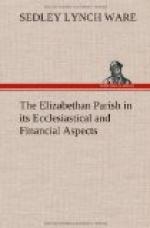It must not be supposed, however, that in the case of offerings or gatherings, or of levies to raise a certain sum where each man assessed himself, it was entirely optional for each to give or to refuse. What a man customarily gave, or what he had promised to give, or, again, what the parish thought he ought to give, that the ordinary might compel him to give.[202] From an offering or a voluntary assessment to a rate is often but a short step, and the two former shade off into the latter almost imperceptibly. The justices of the peace and the ecclesiastical authorities usually cast lump sums upon the parishes, leaving ways and means to the parishioners themselves. But it was, of course, optional with the justices to rate each individual separately when it seemed good to them, and for this they had the Queen’s subsidy books to guide them. Here, however, we are chiefly concerned with the raising of money amongst the parishioners themselves. How manifold, how ingenious were the parochial devices for creating resources, it is the purpose of this chapter to set forth.
But before proceeding to the parish expedients, properly so called, for raising money, it will be well to say something of parish endowments, whether in lands, houses or funds. According as the revenue from these was available for general, or at least for various purposes, or, on the other hand, was impressed with a trust for some specific object, these endowments may be divided into general and special. Parishes well endowed might be able to dispense with some of the devices for money-getting which we shall have occasion to enumerate, but then, after all, endowments might come and they might go;[203] moreover, the financial policy of any one parish would, of course, differ according to the disposition or the ability of those who shaped it.
Of Loddon, Norfolk, we are told that “no complaint appears about Church Rates, for there were none, as the revenue of the Town Farm ... rendered a tax of that description unnecessary."[204]
Of St. Petrock’s, Exeter, we are informed that “the parish became so well endowed by donations of land and houses as to enable the wardens to dispense almost entirely with the quarterly collections entered in the earlier accounts."[205] The editor of the Thatcham, Berks, Accounts, writes: “In the early years of these churchwardens accounts the available funds were derived chiefly from the two oldest charities, one called ‘Lowndye’s Almshouses,’ the first account of which is for the year ... 1561 ... to 1562; the other known as ’the Church Estate,’ the first account of which begins in 1566."[206] Summoned by the Bodmin, Cornwall, justices in January, 159-4/5, to make a report as to the parish stock, the representatives of Stratton certify at sessions that their stock “am[oun]ts to the now some of Sixteene poundes, some yeares it is more & some yeares lesse....” And, they continue, “the vsinge of our sayde stocke is by the two




